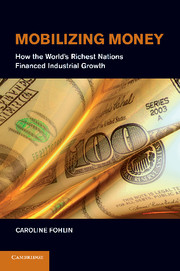1 - Introduction
Published online by Cambridge University Press: 05 January 2012
Summary
Financial systems arise to intermediate between capital owners seeking productive investments and entrepreneurs with profit-making ideas but with insufficient funding. Why they emerge at particular points in time, and why they are organized as they are, remains to be understood in its entirety. From a theoretical standpoint, we have a number of explanations for the endogenous evolution of institutions to bridge the gap between the supply and demand for investment capital. Beyond this simple brokerage function, financial intermediaries also change the nature of assets between borrower and lender; hence, the notion of qualitative asset transformation, or QAT. For the institutions of interest in this book, QAT typically means the alteration of the maturity or liquidity of assets – allowing investors to take part in large-scale, illiquid, and possibly high-risk and extended industrial investment with either a relatively low-risk, high-liquidity, short-maturity (even on-demand) depository account or a moderately risky yet relatively liquid – that is, tradable – equity position in the bank itself. This sort of QAT is effective, in large part, because the intermediary can invest in a wider range of projects than is feasible for the individual and thereby diversifies away some portion of the risk inherent in any one project.
The very fact that brokerage functions are necessary – because suppliers of capital may often be unacquainted with the full range of investment opportunities – raises another potential way that financial intermediaries alter assets: risk profile. In addition to diversifying away the natural risk of industrial investments, banks may also mitigate the problems that can arise when investors have poor information about the quality of investments or their true returns. Banks are well suited to serve this function by screening entrepreneurs before investing and monitoring the progress and performance of projects after investing. In all of these cases, financial intermediaries provide a key service to wealth holders and entrepreneurs, and the premium on their stock or the interest they earn on lending (net of their payments for deposits) constitutes their payment for this service.
- Type
- Chapter
- Information
- Mobilizing MoneyHow the World's Richest Nations Financed Industrial Growth, pp. 1 - 12Publisher: Cambridge University PressPrint publication year: 2011



